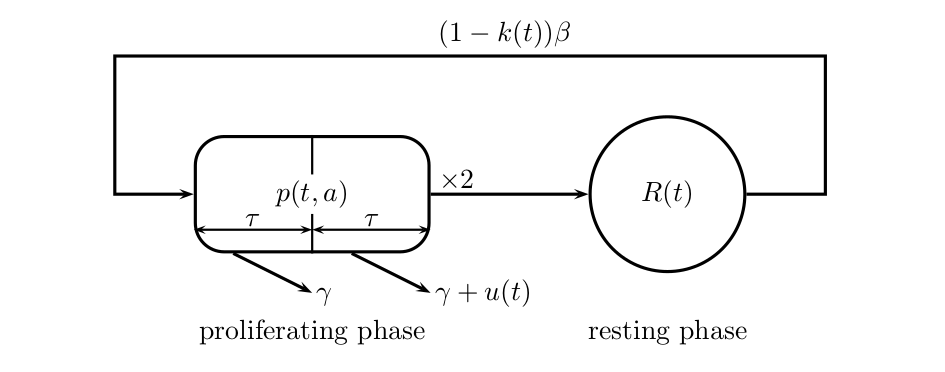We study the optimal control of leukemic cell population presented in [2], namely the optimal use of a combination of cytostatic and cytotoxic drugs in order to reduce the total cancerous cells. The model from [1] and [3] considers two sub-populations of leukemic cells: the inactive resting cells, and the proliferating cells. Resting cells go into the proliferating phase at constant rate . Proliferating cells either die by apoptosis with rate
or divide during mitosis into two daughter cells. Mitosis has a duration of
and the daughter cells start in the resting phase. We introduce the age variable a for the time spent in the proliferating phase, and note
the resting population and
the proliferating population. We consider two drugs: a cytotoxic that induces a death rate
in the second half of the proliferating phase, and a cytostatic
that results in a fraction
of inhibited resting cells that are blocked from entering the proliferating phase. This age-structured model is represented on following figure.
The system follows the dynamics:
In order to handle the transport equation for , we note the total and second half proliferating populations
As detailed in [1] and [2], by the method of characteristics the dynamics can be rewritten as a system of delay differential equations corresponding to a controlled version of Mackey’s model [3].
We refer the reader to [2] for the formal analysis of this system, namely the existence of solutions and the introduction of age-weighted populations to counteract the horizon effect that would cause to always stop all treatment at the end of the time interval. Taking into account constraints on the maximal cumulative dose of drugs, the resulting optimal control problem writes as
where \lambda is defined by the equation and
with the border cases
From [2] we take the initial conditions
and the parameters
Numerical simulations are carried out for three cases: (Fig.2);
, no limit
(Fig.3); and
(Fig.4).
Fig2: Low cytotoxic dose , with cumulative limit. Optimal solution is bang-bang with cytotoxic administered when sub-population
is high.
Fig3: High cytotoxic dose , without cumulative limit. Optimal cytostatic is bang-bang.
Fig4: High cytotoxic dose , with cumulative limit. Both optimal cytostatic and cytotoxic are bang-bang.
References:
[1] M. Adimy, F. Crauste, and A. El Abdllaoui. Discrete maturity-structured model of cell differentiation with applications to acute myelogenous leukemia. J. Biol. Systems, 16(3):395–424, 2008
[2] X. Dupuis. Optimal control of leukemic cell population dynamics. Math. Model. Nat. Phenom., 9(1):4–26, 2014.
[3] M.C. Mackey. Unified hypothesis for the origin of aplastic anemia and periodic hematopoiesis. Blood, 51(5):941–956, 1978.





